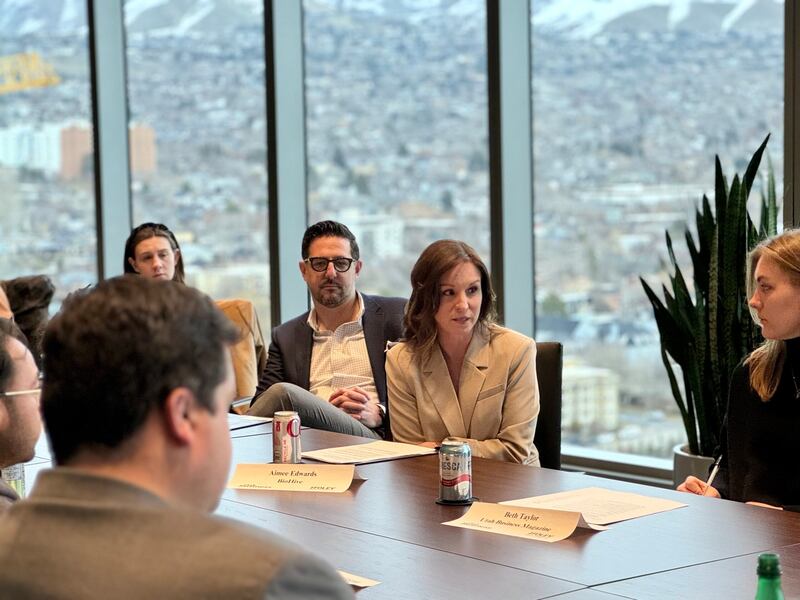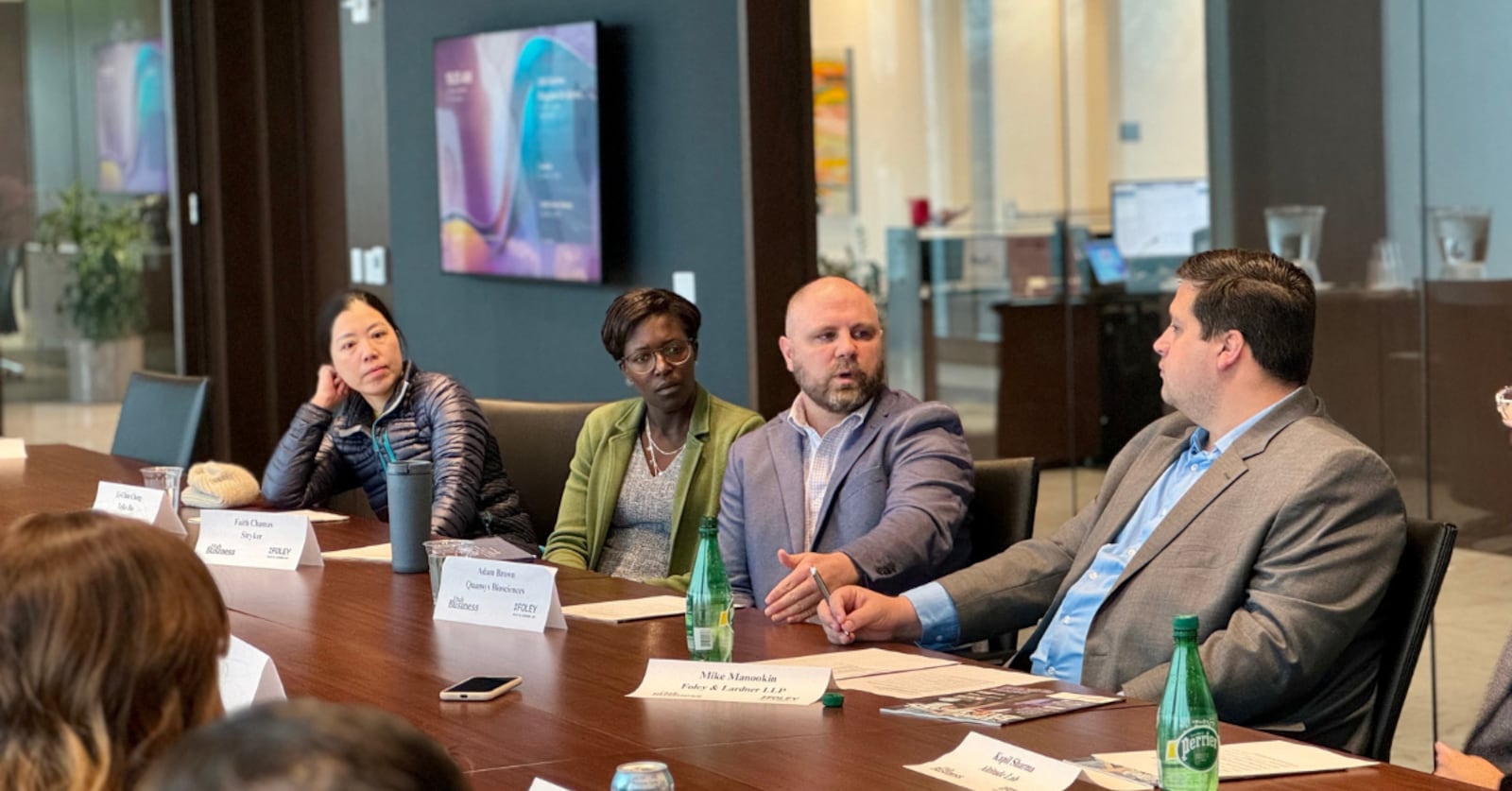This story appears in the March issue of Utah Business. Subscribe.
Last month, Utah Business partnered with Foley & Lardner to host a roundtable on Utah’s life sciences industry. Moderated by Kapil Sharma, program manager at Altitude Lab, they discussed fostering talent, the FDA, innovation and more.
How did Utah blossom into an emerging life science hub? Do you agree with the “hidden gem” perception that our life science ecosystem has?
Jeff Stevens | VP/GM & Global Platform Leader at the Peripheral IV Business | BD
It is a hidden gem. The things going on in Utah’s life sciences are tremendous. Utah has led the nation in job growth in the life sciences. The economy here in Utah has shot up. The “hidden” aspect of it is that there’s not as much attention or publicity around it as Silicon Slopes and the tech industry rise in Utah, but it’s been just as real and just as impactful.
Aimee Edwards | Executive Director | BioHive
We have 182,000 direct and indirect employees and 1,600 companies contributing $21 billion in economic impact for the state. We are a hidden gem. Nobody knows about the life science companies here. Most people could name 20 or 30 companies, but 1,600 is enormous.
Jared Bauer | CEO | Seek Labs & IONIQ Sciences, Inc.
Chairman | BioHive
Medical device [manufacturing] is the history of life sciences in Utah, but it is not the current state. It’s foundational to our ecosystem, but if you look at the makeup of the ecosystem, we’re leaders in diagnostics, research and development. We are also innovators on the digital health side. Our ecosystem today is a well-rounded view of life sciences. Utah has every aspect of what we have traditionally and non-traditionally called life sciences. They are growing and succeeding here. We are no longer simply a device hub.
Adam Brown | CEO & President | Quansys Biosciences
Logan is not quite Utah’s central biotech hub, but it has the highest number of biotech per capita in the state. When we look back at the history of biotech and Logan, it goes back to Dr. Rex Spendlove, who founded HyClone Laboratories, which is now part of Cytiva and Thermo Fisher. A large number of people get into the biotech industry, see what it is, get invested, and then move out to start something new. That’s what we’ve seen in Logan.
How has Utah’s life science ecosystem changed post-COVID-19?
Kelvyn Cullimore | CEO & President | BioUtah
COVID did quite a bit to give exposure to our industry. Many companies gained better visibility and stronger financial footholds to move forward. We also saw more outside talent accessed and a consolidation of executives in Park City—executives with no operations in Utah. That all came about because they realized they could do their job from anywhere and selected our great state.
Mike Kirkness | CEO & President | 3Helix
The grander economic situation killed venture capital, making it challenging to find funding. COVID brought an opportunity, but if you weren’t in the diagnostics and COVID or artificial intelligence (AI) and machine learning spaces, you weren’t really in that venture round. We’re starting to see some spend again, but that was definitely an unintended consequence that we saw if people didn’t switch over to COVID.
Li-Chun Cheng | VP, Lab Operations | Teiko.bio
I moved here about five years ago because of the supportive environment. The cost of infrastructure is also much cheaper than in the Bay Area. In terms of recruiting talent to work in the lab post-COVID, there are some challenges. There is no remote lab work; everybody must be physically in the lab. People hesitate to relocate because once they do, they’re dedicated to being here with their company for a while. I tell my coworkers how good it is to live here—you have ski resorts and nature nearby, and you can buy your own house—but I think we fear for the job market.

What are the benefits of building a life science business here compared to out-of-state?
Faith Chamas | Program Manager, R&D | Stryker
There’s a talent pool here that’s large and untapped—especially in hourly wages. Until you come here and do the networking, you don’t realize how much talent is here in Utah. As far as it being expensive to set up here, when you compare it to California and the East Coast and Minneapolis, it’s advantageous to be here.
Mike Kirkness | CEO & President | 3Helix
Working in Utah is awesome. I didn’t realize how broadly Utah’s industry was admired. I was blown away by all the resources here. The longer I’m here, the more resources I find. I just have no idea how to tap into it all. I feel like my company is doing an excellent job of tapping into resources compared to other smaller companies because we show up to all these events. However, I’m still discovering new resources that I had no idea existed. Altitude Labs pulls us all together, and we have that cohort of people we can rely on. But I think we are missing something more structured. Especially as someone who moved to Utah, we’re missing a peer network of people whom I can commiserate with, learn from, have breakfast with and dive into problems with.
Aimee Edwards | Executive Director | BioHive
At BioHive, our goal is to build the brand and bring people together. We recognize that talking about ideas, challenges or successes is really important. We don’t talk enough about those things, and you don’t hear enough about what’s happening. We’re always happy to connect, and we’re putting resources on our website so we can be more of a resource.
What can we do better as an ecosystem to foster more innovation and talent as an industry?
Jared Bauer | CEO | Seek Labs & IONIQ Sciences, Inc.
Chairman | BioHive
There are some things that could be organized better, but what’s amazing is that we’re learning what works and what the needs are here. We’re innovating with the resources that are available without copycatting Boston or San Francisco. That leads to additional competitive advantage for our companies in the future. We do have massive needs in this state for more expertise. It takes a full spectrum of talents to hold this industry together. Science and engineering are critical pieces, but they are not the whole. We need software developers. We need individuals who are passionate about business and who are passionate about the space.
Aimee Edwards | Executive Director | BioHive
Looking at the student chapters, they just don’t know about the opportunities here. They want to know more about life science companies—what they could do instead of being doctors or working at universities. They are unaware of the opportunities, but as soon as they are, they’re excited and want to get into the space.
Faith Chamas | Program Manager, R&D | Stryker
There is discussion on how to get more resources out there, but it is difficult because we don’t know about all the resources that currently exist. Social sites help post about events, and people are getting more involved, but we need to find better ways. The Life Sciences Summit is growing every year as word gets out. That is helpful because there is a need for cross-pollination. Even if we just get employee resource groups together, we can create that ecosystem.

What specific health care innovation verticals do you see rising in Utah and the life science industry as a whole?
Jeff Stevens | VP & General Manager | BD
Smart, connected care is absolutely something that is driving health care. Traditionally, we think of health care happening largely in hospitals, but the shift outside of the acute care setting, particularly during COVID, accelerated that. We’re going to continue to see shifts with that. Health care will happen in all sorts of places: the hospital, the clinic, at home, everywhere. With tech skyrocketing over the past few decades, Utah is facilitating a coming together of those industries in a way that will be interesting.
Kelvyn Cullimore | CEO & President | BioUtah
Medical device [manufacturing] is dominating. These big companies don’t get big percentage increases, but even a slight increase with 2,000 employees is significant. From a job growth perspective, [medical device manufacturing] continues to provide the most jobs. If you talk about percentage growth, pharmaceuticals have had the highest percentage by far over the last six years. Most people don’t realize that many big companies have a genesis going back to a Utah-based technology or company that was acquired and then built that way.
Chad Testa | CEO | Curza
One thing that’s exciting for me, being in the pharmaceutical industry, is what Chris and Tina at Recursion are doing. They’ve brought in how many people from outside of the state to grow. Then, look at how many people have left Recursion to start their own companies here in town. That’s a huge sign of growth.
How is the Food and Drug Administration (FDA) adapting to health care innovation?
Kelvyn Cullimore | CEO & President | BioUtah
The biggest challenge we have with FDA right now is they are a 1970s institution operating in a 21st century environment, and they don’t have the operational ability. They cannot keep up with the speed of technology development. They spend inordinate resources challenging a company like Owlet, which has a non-significant risk device saving lives when they should be working on a heart valve. Allocation of resources can be a problem at the FDA, but their ability to adapt to the current technology and how fast things are moving in life sciences is a barrier. We’d like to see a revamp of how we approve products, but that kind of change takes a decade to do.
Jared Bauer | CEO | Seek Labs & IONIQ Sciences, Inc.
Chairman | BioHive
I was working with the respiratory division of the FDA, and one of the challenges they face is mass turnover. They had burnout on the agency side. We can express our frustration, but to their credit, they’re also burned out. We are sending technologies to them at a record pace, and their process is not set up for that. When you talk about being able to collaborate with them and work closely with them, they don’t have the bandwidth.

How have you adapted to the current supply chain conditions? Any thoughts on the FDA’s resilient supply chain program?
Adam Brown | CEO & President | Quansys Biosciences
For supply chains, it is sometimes hard to know how much is being affected by the FDA’s part in it. We have supply chain issues right now where we’ve been trying to order one component that’s made overseas, and it’s been back-ordered for six months. Every month, it’s the same thing: “Oh, we’ll have it for you next month!” We’re the middle guy, and it angers the whole chain.
What is the future of AI and machine learning (ML) in the life science industry?
Chad Testa | CEO | Curza
AI and ML are going to have a huge role, but we have to be careful not to overemphasize their role. “Garbage in, garbage out.” If you have a crappy data set, you’re going to get crap out the end. I recently had the idea to use AI and ML to design new antibiotics. The problem is that we need a vast data set, and we just don’t have the numbers available to do what I want to do.
Li-Chun Cheng | VP, Lab Operations | Teiko.bio
AI and ML are a big part of our company. We use them to analyze the immune system of the patient. We used to need an immunologist to look at the data and generate a report. Now, it’s AI and machine learning. But if you have a data set that’s not well annotated, ChatGPT can’t help. That’s why our company provides an end-to-end solution, from sample collection to generating high-quality data to raising the dataset. Then, we trust that data set, and we use AI to give us the analysis. The challenge I see is that there are a lot of new computational tools coming out. We need to evaluate them individually and have a rigorous method to validate them instead of just jumping in.
Mike Manookin | Senior Counsel | Foley & Lardner
It’s got to be used right. It’s a tool you must learn to use now because it’s not going away. It’ll be the next biggest issue in patent laws. We already know you can’t name AI as an inventor, but if you use AI to develop an idea as a big developer, can you patent that idea? Who invented it? I’m the optimist there, though. [AI] is going to make my job easier. I see it as the next frontier. It’s going to make patents better and the review process faster.


